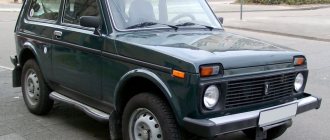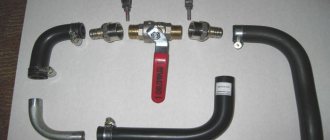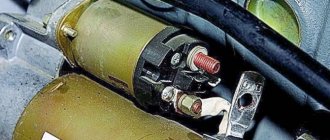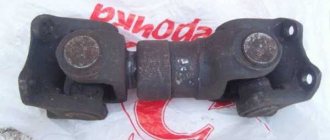The long Niva VAZ-2131 or, as it is now called, LADA 4x4 5D, is just an extended version of the regular short Niva without any significant design changes, with the exception of additional doors. However, the behavior of these two cars is very different both in the city and on the highway, and in off-road conditions. When choosing between a regular LADA 4×4 and a Niva with an extended wheelbase, you need to clearly define the tasks that will be assigned to the car. Let us highlight the main features of the VAZ-2121 and VAZ-2131.
Advantages of a short Niva compared to a VAZ-2131
So, let’s list the obvious advantages of the short-wheelbase Niva:
- permeability;
- maneuverability;
- dynamics;
- body rigidity;
- less consumption;
- less weight.
Appearance of the “old” and updated Niva
All these advantages stem from the short wheelbase and low weight of the LADA 4×4. Now let's look at the long Niva.
Price
Finally, we come to the most pressing issue - cost and maintenance costs. And if the VAZ 2131 and VAZ 2121 are approximately in the same price category, then the Chevy will cost the buyer 1.5 times more. Not everything is so simple with service.
AvtoVAZ's tendency is to reconfigure production at minimal cost.
The result is cars with the same technical components, but with some features of their installation or configuration. Unfortunately, these features come at a price. Thus, maintenance of a Chevrolet Niva, in terms of a certain mileage, will also cost more. It is traditionally believed that the availability of spare parts for Shevik is lower, but at present this information is no longer relevant. As a result, it can be noted that among all Niva models there is no clearly defined flagship, and each model finds its buyer.
A call from an old friend was unexpected: “Listen, I’m about to buy a long Niva, please advise which is better - carburetor or injection?”
So similar.
Indeed, five-door VAZ-2131 Nivas are now produced with a 2130 engine - 1.8 liters and a carburetor power system or a more modest 1.7-liter unit 21214 - with distributed fuel injection. In terms of characteristics, the engines are almost identical: the first has 0.6 Nm more torque, the second is more “revving” and more powerful. one horsepower. The carburetor engine, judging by the passport data, gives the car slightly better dynamics. In addition to the “1.7i” nameplate on the rear, the fuel-injected Niva can be identified by two electric fans - they can be seen under the radiator trim. On a carburetor, the only belt-driven fan is located behind the radiator. The prices of both modifications are approximately equal, even despite the expensive neutralizer and lambda probe for the injection version - about $7,500 in the capital. By the way, there is a suspicion that the introduction of Euro II toxicity standards, planned for January 2004, which means the departure of the carburetor power system from the scene, will be postponed.
. As soon as I began to explain all this, my friend made it clear that he himself was literate - he had already read all the advertising brochures, instructions and specifications. Numbers are numbers, but how does this difference feel behind the wheel? Or is there no difference? Okay, I say, call me back in a week.
Further, as in “The Diamond Arm”: “Are there any similar ones, only blue? No? Will seek". Finally, at the Lada car dealership in Varshavka, we found what we needed: two bright metallic 31 Nivas (plus $300) with the required engines, ready for testing. The next day they were already driving towards the Dmitrovsky training ground.
Sideways - Leaping
At the very first gas station, we exchanged barbs with a colleague: “Listen, why are you twitching like an epileptic, and even scaring people with the clang of the transmission?” - “Look at you - you’re driving sideways, like a dog with a broken paw!” The first remark related to the blue car: due to the unadjusted carburetor, dips were felt in transition modes and jerks that loosened the transmission. And in general, it’s simply impossible to move away without “applying the gas” and “playing” with the clutch! The cherry car has its own problems - the tie rod brackets are welded to the rear axle asymmetrically, which is why the left wheel is shifted forward by 10 mm! Accordingly, the bridge is turned almost half a degree to the right: the car is driving sideways, and the steering wheel is pulling to the side.
Both “Nivas” are related by the howling of transfer cases, tiny exterior mirrors, terribly crunchy door limiters, a heavy fifth door, cheap hard plastic in the cabin, heavy steering wheels without power assistance, shamelessly lying gas indicators, confusing air distribution controls. There are also some strange things: there are leashes for lifting the trunk shelf, but there are no hooks with which they are attached to the door! However, everything is not so bad, there are also advantages: a huge interior, small, precise movements of the gear lever, comfortable seats, pockets in all doors, four soft headrests and the same number of lampshades, a large trunk. In general - “what did you want for such and such money?”
. And so different
Factory instructions do not recommend accelerating faster than 3/4 of the maximum speed in the first five hundred kilometers. We didn’t even accelerate: while we got there, while we did a test run for efficiency, we rode on the hills - we accumulated half a thousand. On the highway, fuel consumption for the carburetor car was 9.8 l/100 km, and for the injection car it was 9.4 l, which is even better than the factory data. When weighed, the second car turned out to be slightly heavier - 4 kg. By the way, both were about 30 kg short of the rated 1350 kg curb weight.
On mountain roads, a poorly adjusted carburetor gave way to a precisely working injection system. The blue Niva inevitably reduced its speed, climbing hills of 4 and 6%, respectively, in V and IV gears. But the cherry climbed smoothly or even with slight acceleration. A very tough test - starting from a stop on a 30 percent climb - confirmed the trend. The injection-powered all-terrain vehicle managed to start, albeit at the limit of its strength, but immediately, the carburetor - only on the third attempt, having slightly scorched the clutch.
The “i”s were dotted by the tests with the measuring system - the carburetor lost outright. The gap was so noticeable that, for the sake of correctness, they decided to repeat the measurements on identical VLI-10 tires (initially, the car with a 1.8 liter carburetor engine was shod with K-156). They changed the wheels, but no miracle happened, the gap barely narrowed. As a result, acceleration to hundreds took 26.3 and 19.8 seconds, respectively—a difference of 6.5 seconds or 25%! In the maximum speed races, the cherry one “brought” the blue one almost 10 km/h and more than a second in the elasticity exercises.
- Hello! Well, how are things with the “fields”, have you figured it out?
- Old man, do you know a motor mechanic who can properly adjust the carburetor? No? Then take an injection and enjoy life.
Over the course of 25 years, the Niva car has received many modifications, and quite recently a new Chevrolet Niva model was released. Let's look at different models and drive them along the same route. After all, not everyone could try all the variations of cars, so read it and decide if something will be useful.
Advantages of the five-door VAZ-2131 compared to the three-door Niva
Thanks to the extended base and increased weight, the SUV has the following advantages:
- road stability;
- smooth ride;
- comfort;
- spacious back row, comfortable seating;
- spacious trunk;
- larger tank volume (65 liters instead of 42 liters on the short Niva);
- large load capacity.
Long wheelbase Niva
Disadvantages of cars
The disadvantages of the short Niva follow from the advantages of the long one: poor handling on the highway, low level of comfort, cramped interior, etc. Accordingly, the disadvantages of the VAZ-2131 follow from the advantages of a short-wheelbase SUV: worse cross-country ability, dynamics, maneuverability, higher consumption.
Read more about cross-country ability
The worse cross-country ability of the VAZ-2131 is justified solely by the extended wheelbase and greater (by about 150-200 kg) weight. Those. If we compare the cross-country ability of these two vehicles on dense soils in the absence of high or deep transverse obstacles (ruts, hillocks, ditches), then in terms of cross-country ability the VAZ-2131 will be only slightly inferior to the VAZ-2121. And in cases where additional mass is beneficial, for example on loose snow or shallow mud, the cross-country ability of a long Niva may be even higher than a short one.
Exterior colors
As mentioned above, many owners of used Nivas decide to replace the body if, as a result of an accident or simply external influence, the metal frame becomes obsolete and its control dimensions change. Note that the new car body is offered in the following color variations.
| Color code | Name | Other |
| 140 | Jasper | Color scheme VAZ 4x4 3-door |
| 202 | Snow white | Color scheme VAZ 4x4 3-door |
| 221 | Glacial | Color scheme VAZ 4x4 3-door |
| 368 | Nessie | Color scheme VAZ 4x4 3-door |
| 420 | Baltika | Color scheme VAZ 4x4 3-door |
| 240 | White cloud | Color scheme VAZ 4x4 5-door |
| 328 | Nice | Color scheme VAZ 4x4 5-door |
| 630 | Quartz | Color scheme VAZ 4x4 5-door |
| 690 | The Snow Queen | Color scheme VAZ 4x4 5-door |
New body colors
It is advisable to get rid of the old body once and for all. Repair is a troublesome business and requires specific knowledge or large financial expenses. And in most cases, repairmen themselves do not recommend restoring a body that is too shabby, since it is impossible to give any time guarantee.
Machine parts
To the undeniable advantages of the Chevrolet - a nice body with good aerodynamics, an updated suspension, an imported hydraulic booster, modern sound insulation - let's add a few non-obvious, but significant ones. This includes an effective ventilation and heating system with a cabin filter, better electrical wiring, and better corrosion resistance of the body.
The obvious disadvantage of the new Niva is the higher cost of the car and its subsequent maintenance. There are, of course, disadvantages that are not so obvious. These include a large shortage of some spare parts. Fortunately, this does not include consumables - pads, rubber bands, etc.
There is no point in giving a list of best-selling spare parts here. Firstly, by the time the magazine is published it will be outdated. Secondly, it’s almost a year since the manufacturer promises to take radical measures to solve the problem - they assure you that there won’t be long to wait.
There are features that are worth paying attention to when asking the price for a VAZ 2131. First of all, decide on the engine - injection or carburetor. The choice in favor of the latter today is motivated not only (and not so much) by a lower price. Against the backdrop of just over eight thousand, which the car will cost after anticorrosive treatment, installation of an alarm system and a radio, the difference of $200 is hardly significant. But the absence of a neutralizer and the ability to service the car in any provincial workshop may be important for the buyer.
Also interesting: The principle of operation of the air conditioner of a Niva Chevrolet car
In turn, an engine with distributed fuel injection pulls better “at the bottom”, allowing you to crawl uphill with a lower gear almost at idle speed. And such an engine has less appetite.
Read news about the new field
- Niva 2121, Niva 2131 and Niva Chevrolet. Let's compare?
- What to choose Chevrolet Niva or UAZ Patriot
- Which is better Chevrolet Niva or Niva 2131
- Chevrolet Niva or Renault Duster, which is better - Chevrolet niva or Renault duster
- Niva 4x4 or Chevrolet Niva: which is better, comparison, how it differs from a simple Lada, which one to choose 2121 or 2231, reviews from car owners
- Which is better Niva or Niva Chevrolet
- Niva Chevrolet and Niva 2121: the main differences between owning these cars
- Niva Chevrolet or Niva 2121: which is better, owner reviews
The world's first crossover: VAZ-2121 Niva - about everything and nothing
Well, let's add something from other sources.
How was the car created?
Soviet designers turned to the idea of creating a comfortable domestic SUV in the late 60s. In any case, work began at AvtoVAZ itself in 1970. Since in those days no issues could be resolved decisively without high authorities, it is worth thanking the Chairman of the USSR Council of Ministers, Alexei Kosygin, for the Niva.
As it turned out, the “kopeks” and “treshki” issued at that time (in various modifications) attracted only city dwellers. Villagers, not spoiled by asphalt roads, preferred the “indestructible” “Muscovites”, which were produced in much more modest series. But the organization of large-scale automobile production on the banks of the Volga was conceived, among other things, in order to “pump out” the money supply of savings that were dead weight for the citizens of the USSR - there was nothing to buy anyway... So they decided to organize the production of an affordable off-road passenger car .
And work began to boil. By the way, parallel - and not unsuccessful - design of an SUV has been carried out since 1965 both at Moskvich (where in 1959-61 the all-wheel drive Moskvich-410 was produced in small series and a prototype of the Moskvich-415 SUV was being prepared), and at GAZ , and at the Izhevsk Automobile Plant (then still a very young enterprise). By 1970, two prototypes had already been created there - Izh-5 and Izh-14 (NAMI engineers took part in their development). VAZ workers started work from scratch.
The first version of the car - E2121 - was nicknamed the “crocodile” for its chopped shapes, which were reminiscent of both the Kubelwagen (a floating SUV of the Wehrmacht) and the Willys - it was born 35 years ago, in April 1972. The body lines were straight, the top was canvas, and the front window was folding. Ideas were tested on this mockup.
As a result of road tests, several basic principles of the future Niva were determined. For example, permanent differential all-wheel drive, the possibility of using front disc brakes, front independent suspension, the presence of a reduction gear and the need to lock the center differential.
It was only later that leading designer Pyotr Prusov, bodybuilder Lev Murashov and designer Valery Semushkin asked the question - why does the VAZ car not have the “Zhiguli” comfort? And then Semushkin drew a new body... However, they didn’t like the car: the designers pointed out that they were moving away from the classic layout of an SUV - a frame structure, leaf spring suspension, solid axles, and a low-speed, large-volume engine.
Also interesting: Chevrolet Niva fuse box with description (up to 2009 model year)
The VAZ team suggested using a monocoque body - no one in the world had ever made such an SUV before. Suzuki Vitara and Jeep Cherokee appeared later. The fate of the SUV was decided by the then general designer of VAZ, Vladimir Solovyov - it was he who convinced the plant’s technical council to once again consider the developers’ proposal. And after very heated debates, the project was approved.
And soon the time came for the first tests - accompanied by military UAZs, camouflaged prototypes (their radiator grille was decorated with a Latin F - Semushkin explained to everyone curious that this was a new Fiat model) passed under their own power through the deserts of Central Asia to the southernmost point of the USSR - the city of Termez. The mileage showed that it is necessary to finish the front suspension, cooling systems, ventilation and air intake.
In addition, it was decided to abandon solid glass doors - they were warped. However, the most serious changes had to be made to the suspension. The plant did not have equipment that would allow the production of synchronous universal joints. I had to buy a license for CV joints from.
And on February 16, 1974, tests began at the Dmitrov test site, in which the VAZ-2121 and Izh-15, which had already received the index, took part. Their performance was compared with the test UAZ-469, Land Rover and Range Rover. No matter how proud people in Izhevsk were of their all-terrain vehicle, tests showed that the vehicle was very “crude.” The Niva was faster (130 km/h versus 120 for the Izh-15), acceleration to hundreds took 22.1 seconds (versus 30.5).
A year later, Niva was shown to the general public. At that time, there were no car shows yet, and the premiere took place in August 1975 at VDNKh.
And finally, it happened: on April 5, 1977, the first production car, the VAZ-2121, rolled off the VAZ assembly line. Those cars had a lot of serial parts from “three-ruble” cars - for example, lights, which were later replaced with more modern “six” ones. And the headlights remained “three-point” for a long time.
Read news about the new field
- Which is better: Chevrolet Niva or Niva 4*4 – choose an SUV
- Niva Chevrolet or Niva 2121: which is better, owner reviews
- Dimensions of Niva Chevrolet. Chevrolet Niva dimensions, dimensions, volumes, Chevrolet NIVA 4x4 ground clearance, trunk
- Niva Chevrolet and Niva 2121: the main differences between owning these cars
- What to choose Chevrolet Niva or UAZ Patriot
- Which is better Niva or Niva Chevrolet
- Niva Chevrolet and Niva 2121: the main differences between owning these cars
- Comparative test of Lada XRAY Cross, Lada Vesta SW Cross and Chevrolet Niva » Lada.Online










